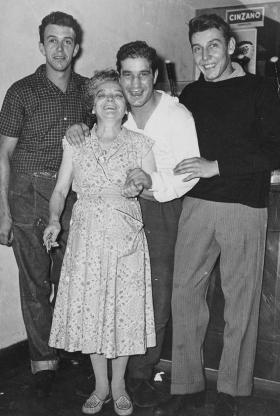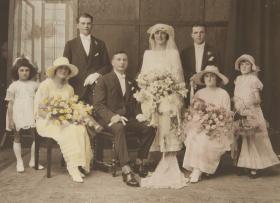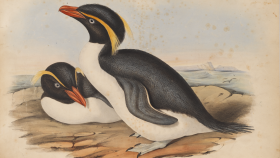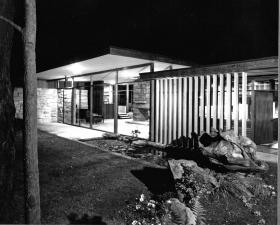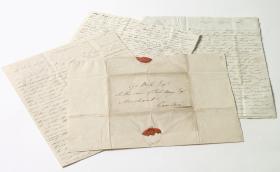Carol Turner’s enthusiasm for family history leaps from the pages of the survey response she sent to me last year. She adores the way the internet makes it possible to collaborate with a global community. ‘Learning from others and sharing what I’ve learned are what keeps the passion alive,’ she writes. ‘Otherwise, it’s just me, a box of dusty documents and a bunch of dead people.’
Family history has become one of the most widely practised forms of public history around the world. My recent research as a Library Fellow focused on the uses and impact of family history in contemporary Australia, England and Canada. Using archival collections in the State Library, surveying family historians and conducting interviews in the Friends Room, I became increasingly interested in how family history research shapes historical consciousness among Australian migrants.
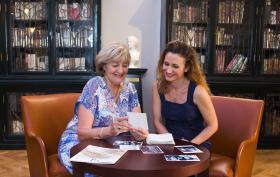
Research on family history provides an insight into how history is undertaken, imagined and discussed. Before the twentieth century, it was largely associated with social aspiration, and among its keenest practitioners were the migrants who had made their homes across colonial empires.
In Australia, family historians established the Society of Australian Genealogists in 1938, coinciding with the sesquicentenary of white settlement. Genealogy became increasingly popular in the lead-up to the 1988 Bicentenary, as scores of self-publications deposited in the Library reveal.
Recent decades have seen a growing academic interest in everyday historical practices, or what American historians Roy Rosenzweig and David Thelen call ‘popular history-making’. National surveys in Australia and Canada have revealed the primacy of family history, confirming that the personal and familial remain people’s ‘principal focus for connection with the past’. The practice of family history has been particularly significant for immigrants.
There are many more people practising this form of community history than is often realised. Family history clearly enables people to construct a sense of community belonging. For many groups — such as immigrants and indigenous peoples (in Australia, Canada and the US, for example) — family histories have existed as counter narratives to dominant national histories from which these groups have frequently been excluded.
The widespread use of the internet among family historians and the impact of DNA research reveal that family history has few geographical boundaries. Family historians around the world recognise, more than most, that settler-colonial subjects are all children of migrants.
One fifth of Canada’s population and over a quarter of Australians are foreign born. Canada introduced its multicultural policy in 1971 and Australia was declared a multicultural nation in 1975. Family history grew exponentially alongside multiculturalism. It has become one of the world’s most popular leisure pursuits, a source of pleasure and education.
You are more likely to see a genealogist or family historian than an academic historian researching in our archives and public libraries. Those of us who spend many happy hours in the Mitchell Library Reading Room know that there are few employed academics in our crowded midst.
These researchers are linking the past to the present in powerful ways, transforming their understanding of themselves and the wider world, but there has been little appreciation of the broader impact of their work.
Italians are among the oldest and most established migrant groups in Sydney, and one of the largest non-Anglo ethnic groups in Australia. The Library has a large archival collection generated by the Italian community, largely through the organisation Co.As.It. Established in Sydney in 1968 ‘to promote the Italian language and culture in NSW and to assist the growing number of migrants arriving from Italy’, Co.As.It launched its Italian Family History Group in 1998.
Maria Linders nee Ravesi, a past chair of this group, was born in Darlinghurst just after the Second World War. When I interviewed her in the Friends Room last year, she told me that her parents migrated to Australia as children. Her father arrived in 1921 when he was five years old with his mother and five siblings. Maria’s mother arrived in 1928. Both were from Salina, one of the Aeolian Islands north of Sicily.
Now semi-retired, Maria became a family historian about 10 years ago — tall, blonde and blue-eyed, she was keen to discover why she looked and felt so different from her southern Italian parents, who were short and dark-haired but also had blue eyes.
The story she told me of growing up in white, assimilationist postwar Australia had parallels with those I have heard from the handful of non-Anglo- Australian family historians I have spoken with. In her youth, Maria fiercely rejected her Italian heritage in response to the racism that surrounded her every day. Her parents spoke Italian in the home, but encouraged their children to speak English in the hope that they would assimilate into white Australia as soon as possible.
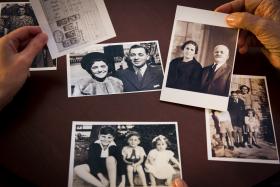
Knowing she could pass as Anglo-Australian, Maria told no one she was Italian. She attended a Catholic girls school in Bondi where there was only one other Italian girl. Her brothers didn’t suppress their Italian identity in the same way, but according to Maria they looked Italian and were subject to less personal restriction because they were male.
She describes herself as a rebel, rejecting her parents’ authority and their ideas of how she should behave. She left her parental home at 21 and married a Dutch man. It’s only in the past decade that her family history research has enabled her to feel ‘more Italian than Australian’ and fostered ‘a greater love for my parents and Italian heritage’.
Maria has been reunited with many members of her family around the world, both online and through reunions in Australia and Italy. Other family members have been encouraged by Maria’s work to begin their own research. Each time she travels to Salina, Maria feels like she is returning home, even though she never travelled there as a child. While she now embraces her Italian heritage, Maria’s lost language skills have been only partially reclaimed in the process.
Talking to family historians like Maria showed me how people strive to create continuity with the past, while maintaining their local identity. My research explores family history’s potential to encourage cultural confidence and cohesion, and foster national and global identities. I look forward to learning more from different migrant groups about their use of libraries and archives around the world.
Associate Professor Tanya Evans is Director of the Centre for Applied History at Macquarie University. She was the 2016 Library Council of NSW Honorary Fellow, and her book Fractured Families: Life on the Margins in Colonial New South Wales (NewSouth Publishing) won the 2016 NSW Premier’s Award for Community and Regional History.
If you migrated to Australia and would like to share your experience of family history research, please contact Tanya Evans.

